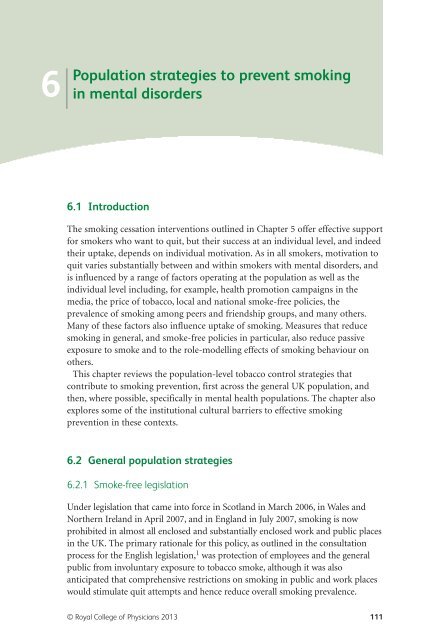Smoking and mental health - NCSCT
Smoking and mental health - NCSCT
Smoking and mental health - NCSCT
Create successful ePaper yourself
Turn your PDF publications into a flip-book with our unique Google optimized e-Paper software.
6<br />
Population strategies to prevent smoking<br />
in <strong>mental</strong> disorders<br />
6.1 Introduction<br />
The smoking cessation interventions outlined in Chapter 5 offer effective support<br />
for smokers who want to quit, but their success at an individual level, <strong>and</strong> indeed<br />
their uptake, depends on individual motivation. As in all smokers, motivation to<br />
quit varies substantially between <strong>and</strong> within smokers with <strong>mental</strong> disorders, <strong>and</strong><br />
is influenced by a range of factors operating at the population as well as the<br />
individual level including, for example, <strong>health</strong> promotion campaigns in the<br />
media, the price of tobacco, local <strong>and</strong> national smoke-free policies, the<br />
prevalence of smoking among peers <strong>and</strong> friendship groups, <strong>and</strong> many others.<br />
Many of these factors also influence uptake of smoking. Measures that reduce<br />
smoking in general, <strong>and</strong> smoke-free policies in particular, also reduce passive<br />
exposure to smoke <strong>and</strong> to the role-modelling effects of smoking behaviour on<br />
others.<br />
This chapter reviews the population-level tobacco control strategies that<br />
contribute to smoking prevention, first across the general UK population, <strong>and</strong><br />
then, where possible, specifically in <strong>mental</strong> <strong>health</strong> populations. The chapter also<br />
explores some of the institutional cultural barriers to effective smoking<br />
prevention in these contexts.<br />
6.2 General population strategies<br />
6.2.1 Smoke-free legislation<br />
Under legislation that came into force in Scotl<strong>and</strong> in March 2006, in Wales <strong>and</strong><br />
Northern Irel<strong>and</strong> in April 2007, <strong>and</strong> in Engl<strong>and</strong> in July 2007, smoking is now<br />
prohibited in almost all enclosed <strong>and</strong> substantially enclosed work <strong>and</strong> public places<br />
in the UK. The primary rationale for this policy, as outlined in the consultation<br />
process for the English legislation, 1 was protection of employees <strong>and</strong> the general<br />
public from involuntary exposure to tobacco smoke, although it was also<br />
anticipated that comprehensive restrictions on smoking in public <strong>and</strong> work places<br />
would stimulate quit attempts <strong>and</strong> hence reduce overall smoking prevalence.<br />
© Royal College of Physicians 2013 111














